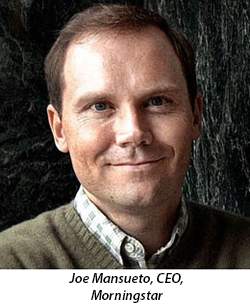Joe says that a majority of investors around the world feel the need for a financial advisor and the growth of the Indian mutual fund industry is not going to be inhibited due to the introduction of direct plans.
Fund houses have been asked by the Indian regulator to introduce a direct share class structure in India. Do you think it will attract investors?
 It
attracts a certain kind of investors who are self-directed. What we have seen
around the world is that investors who can’t manage their assets typically
desire the services of financial advisors. So a majority of investors do want
to work with advisors and then advisors need to be paid. So I don’t think it
should inhibit the growth of the industry. It may broaden the appeal of Indian
mutual funds to more cost conscious individual investors who are self-directed.
It someway expands the market rather than detracting from the distributors and
AMCs. Financial advisors need to show value and be more than a sales person.
It
attracts a certain kind of investors who are self-directed. What we have seen
around the world is that investors who can’t manage their assets typically
desire the services of financial advisors. So a majority of investors do want
to work with advisors and then advisors need to be paid. So I don’t think it
should inhibit the growth of the industry. It may broaden the appeal of Indian
mutual funds to more cost conscious individual investors who are self-directed.
It someway expands the market rather than detracting from the distributors and
AMCs. Financial advisors need to show value and be more than a sales person.
Unlike in overseas markets, investors here are sometime reluctant to pay advisors for their services. What can be done to overcome this challenge?
People need to pay advisors for their services. Entry load is not necessarily a bad thing if investors hold on for a long period of time. It could be an efficient way to buy a fund. I think moving advisors to a fee based model and taking investor’s best interests into account is the higher ground. I prefer a hybrid model. At times, you can have an entry load but also a fee based business. Both entry load and fee based model can co-exist in a way which serves investors well. The key thing is to get more people invest in mutual funds. That’s the greater good. Whatever regulators could do to encourage that, I think it’s the good thing.
SEBI has allowed AMCs to hike expense ratio to expand the market. How do you see this move?
I have never heard of that happening where a regulator allows a higher expense ratio for fund companies to expand geographically. It’s a novel idea to expand the market. So I certainly applaud that. But at the end of the day, the investor needs to have good experience with funds. If AMCs charge more the end customer might suffer. If AMCs charge more and if investors don’t have a good experience, even though if distributors are there in rural towns, investors won’t come back.
Investment advisors in India will soon be regulated. What has been the overseas experience?
Globally, there has been a lot of regulation around distributors for a long time. There are many aspects to it but overall the effect has been good. There have been regulations about suitability - are advisors getting to know clients and putting the clients in funds that are appropriate for their situation? There is also a general movement towards fiduciary responsibility to ensure that advisors are taking the client’s best interests into account.
How should advisors take an informed call based on your ratings?
Ratings are a starting helping point but not an end point. They are not a simple ‘buy’ or ‘sell’ signal. Ratings narrow down the large universe of funds into a more manageable number which the advisors or investors can then research. Whether you are looking at star rating or forward looking bronze/silver rating, to look at higher rated funds is a great starting point. From there, the advisor should do more diligence in selecting the right funds that meet client needs. So I think ratings are helpful in eliminating a lot of poor funds that you don’t want to waste time looking at. I would suggest advisors to look at our analyst forward looking ratings which are ‘highest conviction’ funds and which we believe will outperform on a risk-adjusted basis over a complete market cycle.
Generally, star rated funds attract more inflows but we have seen that a few five star rated funds are managing very small corpus. How far do you think star ratings help attract inflows?
We have seen this trend in some other parts of the world too. I am not sure if we have observed that in India. But there has been a correlation between our rating and fund inflows. A lot of studies have been done on the Morningstar fund ratings and fund inflows. One of the benefits that we provide is that we cover smaller funds that are doing terrific that deserve more assets and more investor attention. So one of the great things about Morningstar is about finding these hidden gems.
What changes/modifications have you brought in your fund ratings over the years?
Our star rating was the first rating that we launched. And that incorporates performance, risk and cost. First we were doing it with every broad group of equity and fixed income funds. Ten years after we launched our ratings, we narrowed down the categories (large, large-value, rating funds against their peer category, etc.). That was the improvement. The next change was a year ago when we launched our forward looking analyst rating which takes an analyst’s best judgment about the fund’s ability to outperform going forward. It’s based on five pillars - parent, people, process, performance and price. It’s a rigorous framework which goes to a rating committee and there’s an in-depth analyst report that underpins our ratings.
Sometimes fund performance gets affected if a star fund manager moves from one fund house to another. Does institutionalizing fund management process help overcome this challenge?
Our reports show the date from when a fund manager has started managing that particular fund – this helps the investors know that how much of the track record is due to the fund manager. We certainly have this information and that’s one thing that benefits our analyst’s ratings. Our analyst’s ratings can incorporate a new manager and we don’t have to wait for the track record. So when a star fund manager comes over to a new fund, we can increase the rating at a much greater velocity if we like the new manager than we could with our historical star ratings.
Funds ratings are normally based on past performance. To what extent can these ratings be an indicator of future performance?
We have done a lot of research on this and there is a mild predictive power to the star ratings. I won’t say that performance is harder to predict for the future. Risk and cost tends to be more constant. So there are elements of star ratings that are more constant. Overall, five star funds tend to outperform four star funds and so on. So, there does seem to be some predictive power within the star rating.
You started Morningstar from scratch. How has been the journey and what are your plans?
It’s been terrific. We have been around for 28 years. We have been fortunate to build up a global brand a terrific lineup of products and a great team. I think there’s a lot of untapped potential. I want to keep the company focused on helping investors attain better investment outcomes and achieve greater integration globally integrated so that we operate as one Morningstar around the world.
In which countries are you planning to spread?
Recently we opened offices in Brazil, Chile, Mexico and in Dubai in the Middle East.
What products and services do you offer in India?
We offer Morningstar Direct which is our flagship software package for institutions. We offer data feeds and databases. We offer investment consulting services.
What is your outlook on the Indian mutual fund industry?
I’m optimistic on the long term growth of the Indian fund industry. Penetration is still in the single digits. If you look at the US markets it’s as high as 40%. With rising affluence and a growing investor class, you’ll have rising penetration over time which could make for a very robust fund market in India. Improvement in markets will be a catalyst.
Is your profitability getting affected due to the tough phase which Indian fund industry is going through at this juncture?
We haven’t seen it impacting us yet. We have been in India for four years now and we have grown every year. Our sales are up by a healthy number this year.




